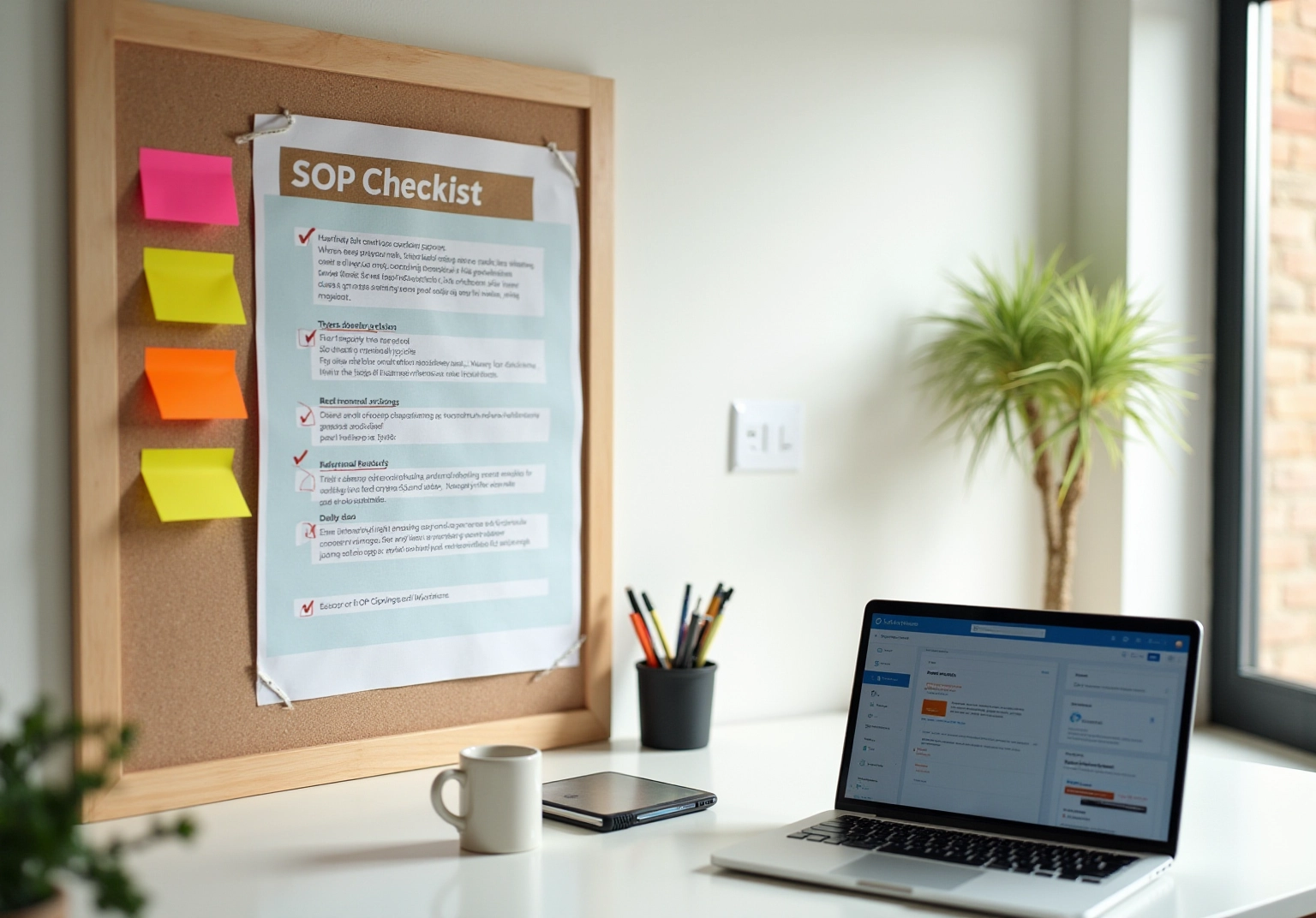
Overview
You might be wondering how to create an effective Standard Operating Procedure (SOP) checklist. Well, it’s all about a simple four-step process that really emphasizes clarity, collaboration, and regular updates. These elements are key to enhancing consistency and efficiency in how tasks get done. So, let’s break it down:
- Identify the process
- Gather input from your stakeholders
- Establish a review schedule
These steps work together to ensure that your SOP stays relevant and practical for your organization's needs. Now, doesn't that sound manageable?
Key Highlights:
- An SOP framework serves as a guide for consistent and correct task execution, reducing mistakes and enhancing productivity.
- Key benefits of an SOP checklist include consistency, efficiency, training support, and compliance with regulations.
- Steps to create an SOP checklist involve identifying the process, defining the scope, gathering input, breaking down stages, including resources, reviewing, and finalising the document.
- Challenges in SOP development include lack of clarity, resistance to change, insufficient training, keeping the list current, and overcomplication.
- Regular maintenance of the SOP checklist is crucial, involving establishing a review schedule, soliciting feedback, monitoring process changes, documenting revisions, communicating updates, and archiving old versions.
Introduction
You might be wondering how creating a Standard Operating Procedure (SOP) checklist can really change the way organizations handle tasks. Well, it can actually ensure consistency and efficiency across all processes! This essential tool not only streamlines operations but also acts as a vital resource for training and compliance.
But let's be honest: developing an effective SOP checklist can be quite the challenge. From defining clear processes to keeping everything relevant over time, there’s a lot to consider.
So, how can organizations tackle these complexities and create a checklist that boosts productivity while meeting their unique needs? Now, let’s dive into that!
Understand the Purpose of an SOP Checklist
An SOP framework is like your go-to guide for getting things done right. It lays out the steps you need to take for a specific task or process, making sure everything is done consistently and correctly. This not only cuts down on mistakes but also boosts productivity. You might be wondering how to make the most of your SOP document. By defining its purpose, you can pinpoint key areas like compliance, training, and quality assurance that it will cover. This clarity helps you tailor your checklist to meet your organization's unique needs, ensuring it’s practical and effective.
Now, let’s talk about the key benefits of having an SOP checklist:
- Consistency: It makes sure everyone’s on the same page, performing tasks uniformly across the organization.
- Efficiency: By streamlining processes, it saves you time and resources.
- Training Tool: It’s a fantastic resource for onboarding new employees, helping them get up to speed.
- Compliance: It keeps you in line with industry regulations and standards.
By grasping these concepts, you’re setting the stage for creating a solid SOP checklist that aligns with your organization’s needs. So, are you ready to dive in and explore how to make your documentation shine?
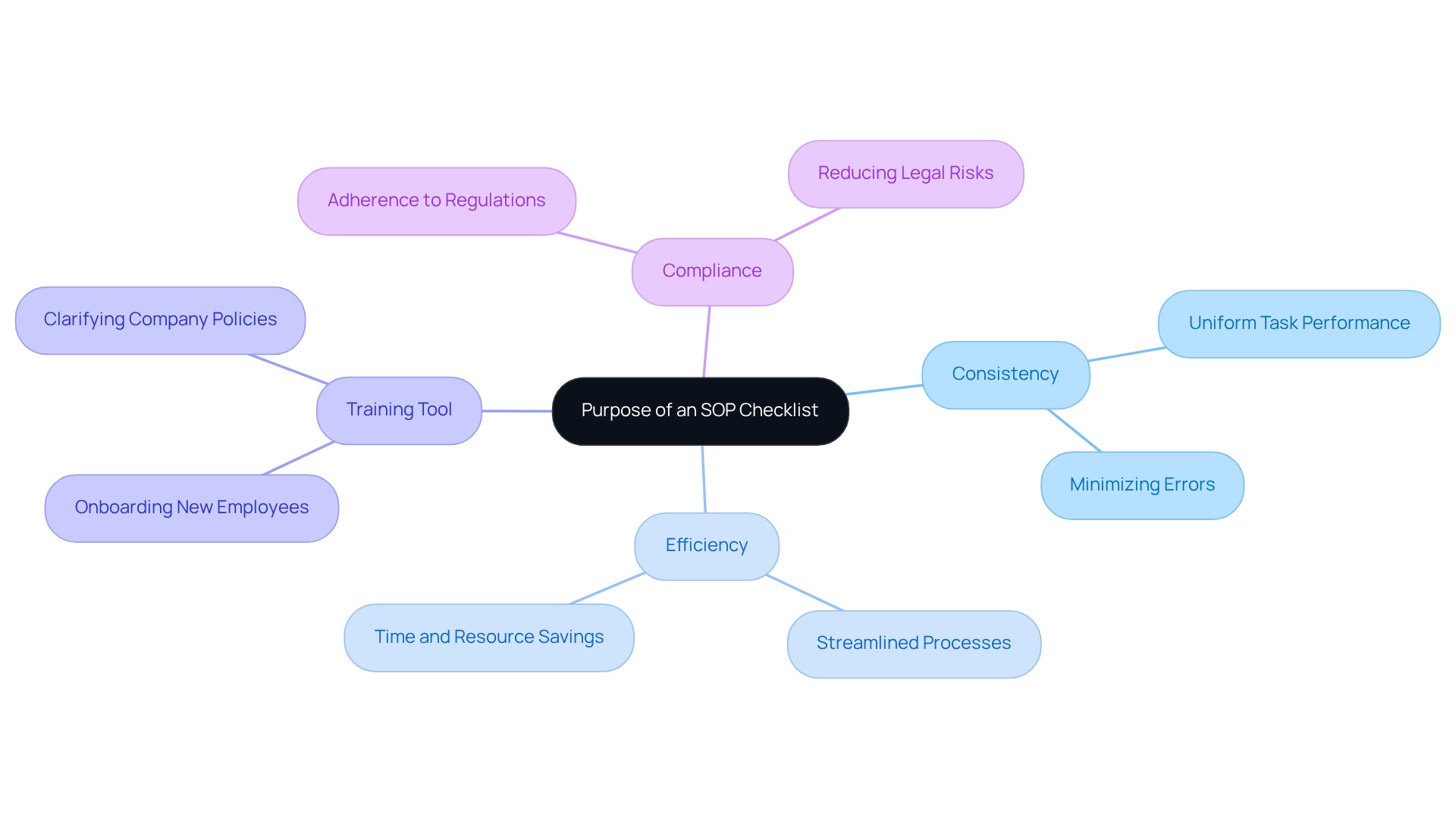
Follow Steps to Create Your SOP Checklist
Creating an effective SOP checklist may seem daunting, but it doesn’t have to be! Let’s break it down into some key steps that will make the process a breeze:
-
Identify the Process: You might be wondering where to start. Begin by pinpointing which specific process or task needs an SOP guide. Chat with your team members who regularly handle the task; their insights will be invaluable in making sure your checklist meets real-world needs.
-
Define the Scope: Next up, let’s talk boundaries. Clearly outline what’s included in your SOP list and what’s not. This helps prevent any confusion and ensures that everyone understands the focus of the list.
-
Gather Input: Now, it’s time to collaborate! Get feedback from stakeholders, including subject matter experts and frontline employees. This team effort guarantees that your checklist is comprehensive and truly reflects the collective knowledge of your crew.
-
Break Down the Stages: Here’s where you’ll want to list each phase of the process clearly and concisely. Use simple, action-oriented language to make it easy to follow. Visual aids like flowcharts or diagrams can work wonders for clarity!
-
Include Resources: Don’t forget to identify any tools, documents, or personnel needed to complete each step. This will help users know exactly what resources they need to stick to the list, boosting operational efficiency.
-
Review and Revise: Once you have a draft, share it with your stakeholders for feedback. Regular updates based on their input will keep your list clear and efficient, transforming it into a living document that evolves with the process. And remember, information retention drops to 70% within 24 hours—so clear and regularly updated SOPs are a must!
-
Finalize and Distribute: After getting the green light, share the list with all relevant team members and make sure it’s easy to access. This accessibility is crucial for keeping everyone aligned with the SOP and ensuring they can refer to it whenever needed.
By following these steps, you’ll create a practical and effective SOP checklist that enhances operational efficiency and supports consistent task execution. As Richard Thompson, Sr Project Manager, wisely says, "With clear-cut, comprehensive standard operating procedures on-hand at all times, your team members will always know exactly what to do in any situation they face." So, let’s get started on making those SOPs work for you!
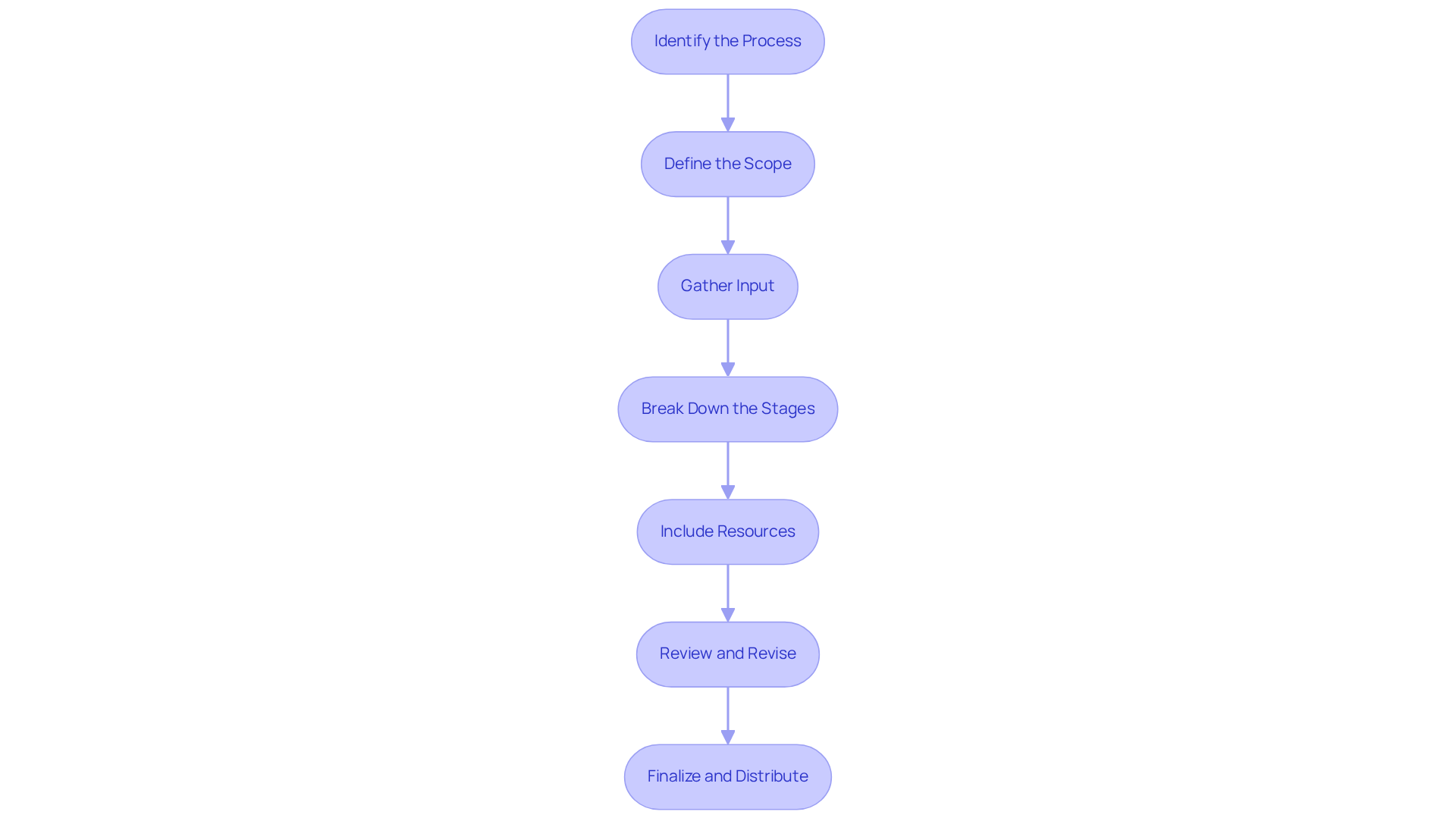
Overcome Challenges in SOP Checklist Development
Creating an effective sop checklist can be quite the challenge, right? Let’s dive into some key issues you might face and explore strategies to tackle them together:
-
Lack of Clarity: You know how unclear procedures can really throw a wrench in compliance? To boost clarity, try using straightforward language and sprinkle in some practical examples to illustrate each step. It makes a world of difference!
-
Resistance to Change: Ever noticed how employees often resist new procedures? To ease this transition, get your team involved in creating the procedures. Highlight how the SOP will make their daily tasks easier and boost productivity. Research shows that organizations that include employees in change initiatives see a 12% increase in success rates. Dr. Jeremy Pollack even points out that successful change efforts thrive on employee participation and good communication.
-
Insufficient training can lead to confusion about how to use the sop checklist. So, why not implement some comprehensive training sessions? Providing accessible resources will help ensure everyone feels confident using the new SOP.
-
Keeping the List Current: As workflows change, your SOP document should too! Establish a regular review process that incorporates a sop checklist to keep the list relevant and precise, adapting to any shifts in procedures or technology.
-
Overcomplication: A list that’s too detailed can become a headache. Focus on the key actions to keep it usable and effective, ensuring that it serves its purpose without overwhelming anyone.
By proactively addressing these challenges, your organization can foster a smoother development process and facilitate the successful implementation of SOP guidelines. This approach ultimately leads to improved operational efficiency. So, what do you think? Ready to tackle these issues head-on?
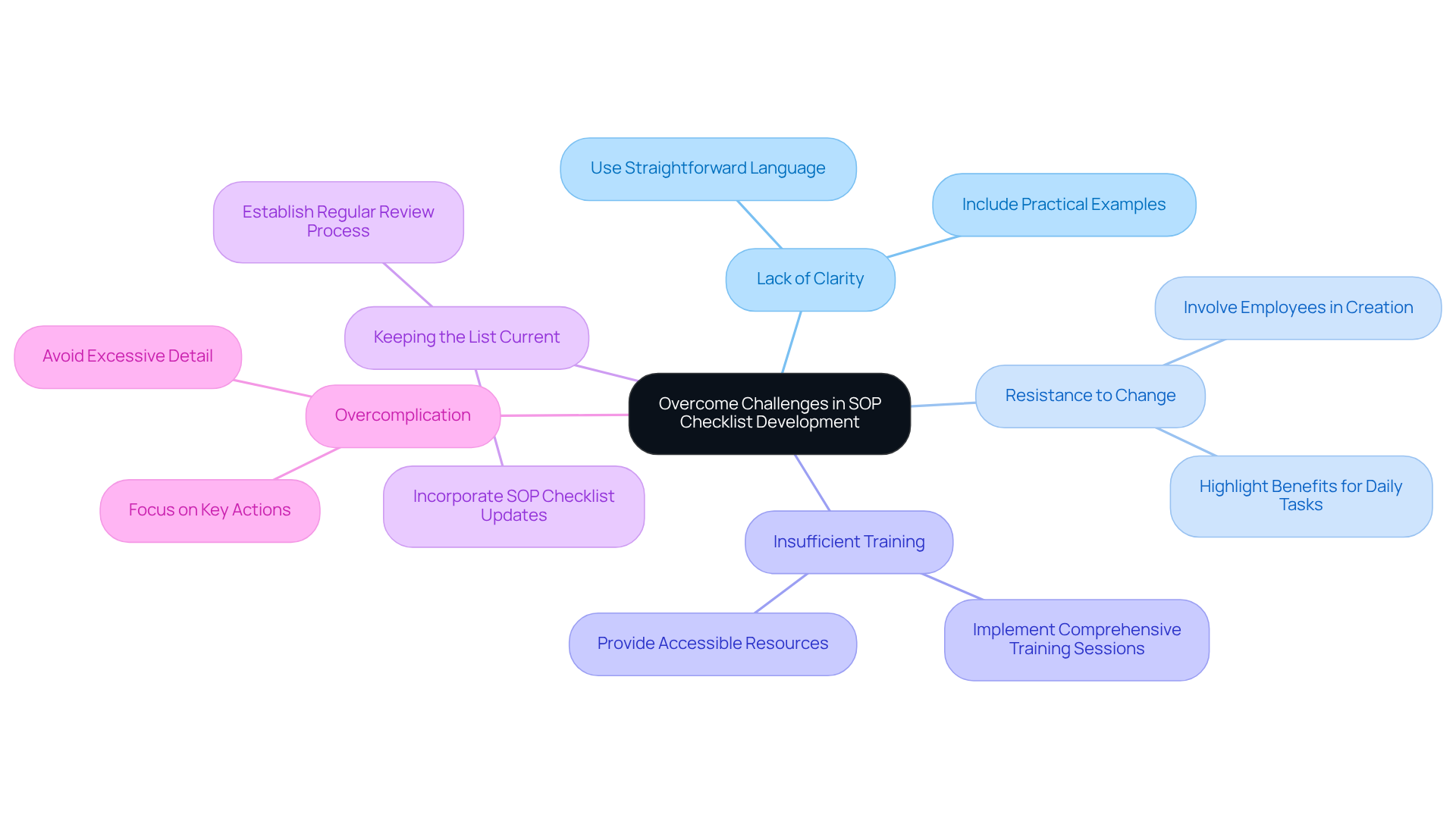
Maintain and Update Your SOP Checklist Regularly
To keep your SOP list effective, regular maintenance and updates are key. You might be wondering how to do that, so here are some best practices to consider:
-
Establish a Review Schedule: Why not set a timeline for regular evaluations of your SOP list? Ideally, aim for quarterly or bi-annual reviews. This way, you'll ensure consistent checks for relevance and accuracy, helping your organization adapt to any changes in processes or regulations. Scheduled reviews keep your SOPs fresh and reduce the risks of non-compliance or operational hiccups.
-
Solicit Feedback: Have you thought about encouraging users to share their thoughts on the list's usability? Research shows that user feedback can really boost the effectiveness of SOP documents, revealing areas that need a little love and attention. As SowFlow puts it, "SOPs are living documents. Encourage feedback from users and update them based on lessons learned."
-
Monitor Changes in Processes: Stay alert for any changes in processes or regulations that could impact your SOP list. It's crucial to make adjustments quickly to ensure your list reflects the current operational landscape, keeping compliance and efficiency in check. Remember, SOPs help your organization meet legal requirements and safety standards during audits.
-
Document Revisions: Keep a solid record of all updates made to the list, including when and what changes were made. This documentation not only tracks the evolution of your SOPs but also builds transparency and accountability within your organization.
-
Communicate Updates: When you revise the list, make sure to inform all relevant team members right away. It's vital that everyone understands the updates and knows how to implement them to maintain operational consistency.
-
Archive Old Versions: Don’t forget to keep older versions of the SOP document for reference. This practice gives you a historical record and ensures that previous procedures can be reviewed if necessary.
By following these practices, you can create a dynamic and effective SOP checklist that meets your operational needs, ultimately boosting productivity and compliance. So, are you ready to dive in and make those updates?
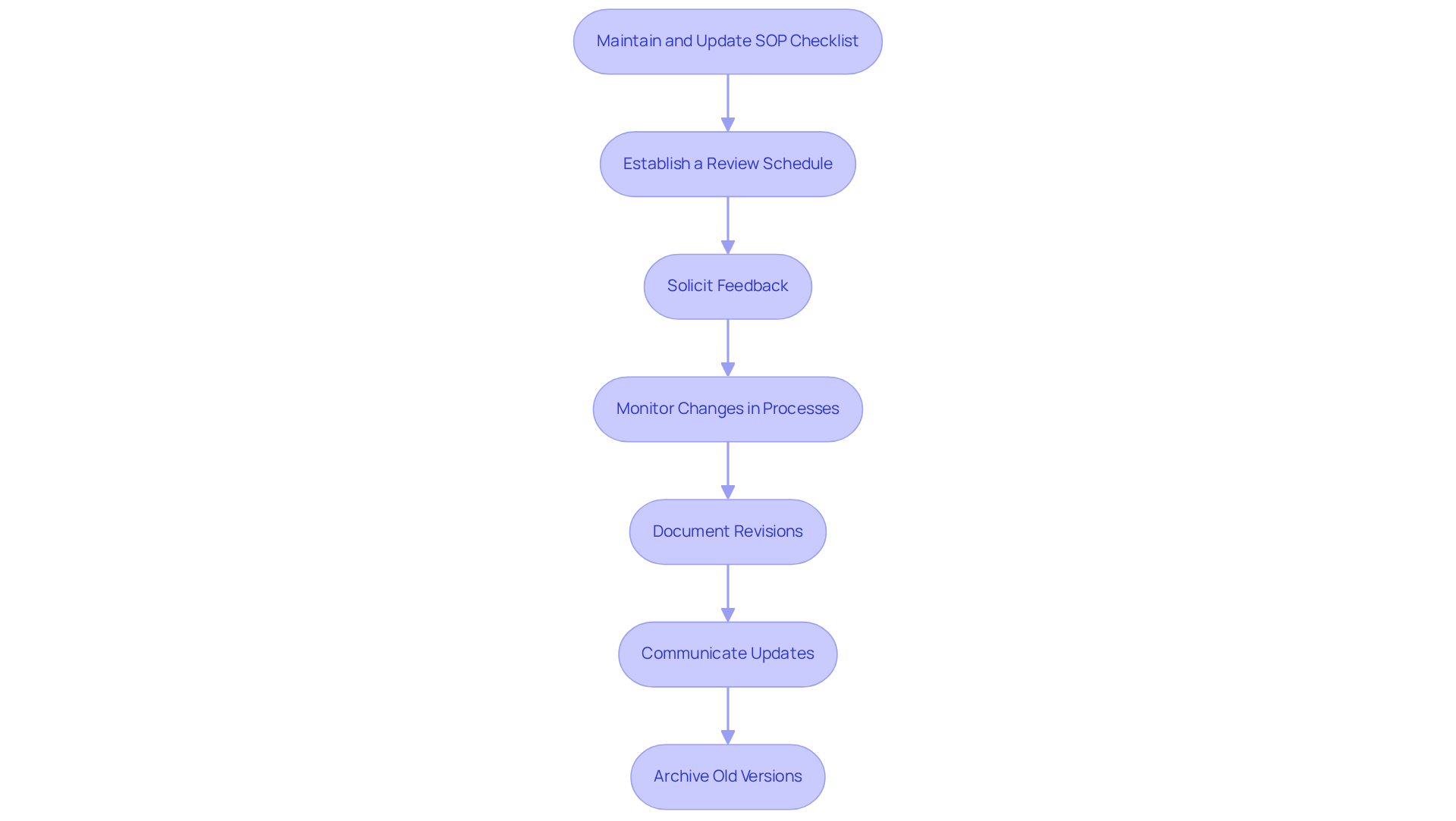
Conclusion
Creating an effective SOP checklist is super important for keeping things consistent, efficient, and compliant in any organization. You might be wondering how an SOP checklist can help your team. By understanding its purpose and following a structured approach, you can really boost your operational productivity and training processes. This guide has laid out the steps you need to identify processes, gather input, and keep a living document that grows with your organization.
Now, let’s dive into some key insights from this article. Clarity, collaboration, and regular updates are crucial in developing your SOP checklist. By tackling common challenges—like resistance to change and not enough training—you can make the implementation smoother and build a culture of continuous improvement. Plus, setting up a review schedule and asking for user feedback are essential practices to ensure your checklist stays relevant and effective.
Ultimately, the significance of a well-crafted SOP checklist can’t be overstated. It’s a vital tool for aligning your team's efforts, enhancing compliance, and streamlining processes. So, why not take proactive steps in creating and maintaining your SOP checklists? Embrace the chance to refine your operations and empower your workforce! By doing this, you’ll not only boost productivity but also lay the groundwork for sustained success in our ever-evolving business landscape.
Frequently Asked Questions
What is the purpose of an SOP checklist?
An SOP checklist serves as a guide for completing specific tasks or processes consistently and correctly, reducing mistakes and boosting productivity.
How can defining the purpose of an SOP document help?
Defining the purpose helps identify key areas such as compliance, training, and quality assurance, allowing you to tailor the checklist to meet your organization's unique needs.
What are the key benefits of having an SOP checklist?
The key benefits include ensuring consistency in task performance, improving efficiency by streamlining processes, serving as a training tool for new employees, and maintaining compliance with industry regulations and standards.
How does an SOP checklist contribute to training new employees?
An SOP checklist acts as a resource for onboarding new employees, helping them understand processes and get up to speed quickly.
In what way does an SOP checklist enhance compliance?
It ensures that organizational processes align with industry regulations and standards, helping maintain compliance.
👍
What others are liking
5 Steps to outline your ideal documentation structure
5 MINS READ
Where to start the your journey of mapping out your ideal documentation structure, aligning it with the very heartbeat of your organization?
Defining a winning level of detail in your process
3 MINS READ
What is too much detail, and what is too little? This article described in that winning level detail about what detail is enough.





